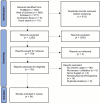Access to dental services for children: a scoping review on the impact of COVID-19 and implications for future models of care
- PMID: 40374219
- PMCID: PMC12083317
- DOI: 10.1136/bmjopen-2024-097256
Access to dental services for children: a scoping review on the impact of COVID-19 and implications for future models of care
Abstract
Background: The COVID-19 pandemic had detrimental effects on routine health and social care as countries instituted widespread public health measures to control transmission of SARS-CoV-2. This affected care delivery for many chronic and non-communicable diseases, including oral health and dental diseases with implications in the postpandemic period.
Objectives: This scoping review, conducted in accordance with the Preferred Reporting Items for Systematic reviews and Meta-Analyses for Scoping Review guidelines, aims to synthesise evidence regarding the impact of COVID-19 on access to dental services among children and their implications for future models of care, especially for children from low-income families, to inform policy decision making around subsidised dental services in Australia.
Data sources: PubMed, Web of Science, Embase, Cochrane Library of Systematic Reviews and Cochrane Central Register of Controlled Trials.
Eligibility criteria: Primary studies of any design published between 1 January 2020 and 31 July 2024. Included studies described provision of paediatric dental services, considered components of access or utilisation and were published in English. Excluded studies were those that only evaluated maxillofacial services.
Data extraction and synthesis: Data were extracted using a standardised template in MS Excel then analysed to thematically classify findings based on key areas of impact. Quality assessment of studies was not conducted.
Results: 54 articles from 17 countries were included. Studies identified reductions in service availability and utilisation, including patient and parent-driven demand. Changes to the configuration of services included greater rates of emergency treatment, reductions in use of aerosol-generating procedures and more use of teledentistry, as well as self-management and prevention approaches. Substantial delays to routine dental care, leading to more dental problems and ongoing need, especially untreated dental caries, were observed with a disproportionate impact on socioeconomically disadvantaged and vulnerable children and families.
Conclusion: The COVID-19 pandemic has had pronounced negative effects on the provision of primary and secondary dental care for children around the world. Access to care was affected by disruptions to service availability and by changes in demand for services related to parental anxiety around the risk of COVID-19 transmission. Delays in receipt of routine dental care and changes to oral health behaviours are likely to lead to an increased need for oral health services, with service adaptations needed to ensure this increased demand can be met.
Keywords: COVID-19; Dental Implants; Health Equity; Health Services Accessibility; Health policy; Quality in health care.
© Author(s) (or their employer(s)) 2025. Re-use permitted under CC BY-NC. No commercial re-use. See rights and permissions. Published by BMJ Group.
Conflict of interest statement
Competing interests: SHD is employed by the Australian National University and seconded to the Australian Government Department of Health and Ageing undertaking action research in relation to COVID-19 and primary care. APS is supported by the Australian Government Medical Research Future Fund and the Tyree Foundation. He holds appointments at The George Institute for Global Health and UNSW Sydney. DJ is a dentist in private practice and also employed by the Australian Government Department of Health and Aged Care as a dental adviser. MK was a salaried officer of the Australian Government Department of Health and Aged Care; he now holds academic appointments with the University of Oxford and the University of New South Wales. He is a Director of Therapeutic Guidelines Ltd.
Similar articles
-
Beyond the black stump: rapid reviews of health research issues affecting regional, rural and remote Australia.Med J Aust. 2020 Dec;213 Suppl 11:S3-S32.e1. doi: 10.5694/mja2.50881. Med J Aust. 2020. PMID: 33314144
-
Folic acid supplementation and malaria susceptibility and severity among people taking antifolate antimalarial drugs in endemic areas.Cochrane Database Syst Rev. 2022 Feb 1;2(2022):CD014217. doi: 10.1002/14651858.CD014217. Cochrane Database Syst Rev. 2022. PMID: 36321557 Free PMC article.
-
Global oral health policies and recommendations for children with special health care needs and their applicability and effectiveness during the COVID -19 pandemic: a systematic review.Evid Based Dent. 2024 Jun;25(2):113. doi: 10.1038/s41432-024-00992-x. Epub 2024 Mar 15. Evid Based Dent. 2024. PMID: 38491169
-
Impact of the COVID-19 era on preventative primary care for children 0-5 years old: a scoping review protocol.Syst Rev. 2024 Apr 26;13(1):113. doi: 10.1186/s13643-024-02507-2. Syst Rev. 2024. PMID: 38671488 Free PMC article.
-
Access to oral healthcare for children during the COVID-19 pandemic: a mixed-methods study in the Aegean region of Türkiye.BMC Oral Health. 2025 May 2;25(1):680. doi: 10.1186/s12903-025-06053-8. BMC Oral Health. 2025. PMID: 40317032 Free PMC article.
References
Publication types
MeSH terms
LinkOut - more resources
Full Text Sources
Medical
Miscellaneous

